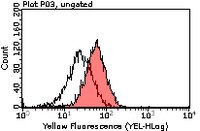CEACAM1 regulates TIM-3-mediated tolerance and exhaustion.
Huang, YH; Zhu, C; Kondo, Y; Anderson, AC; Gandhi, A; Russell, A; Dougan, SK; Petersen, BS; Melum, E; Pertel, T; Clayton, KL; Raab, M; Chen, Q; Beauchemin, N; Yazaki, PJ; Pyzik, M; Ostrowski, MA; Glickman, JN; Rudd, CE; Ploegh, HL; Franke, A; Petsko, GA; Kuchroo, VK; Blumberg, RS
Nature
517
386-90
2015
요약 표시
T-cell immunoglobulin domain and mucin domain-3 (TIM-3, also known as HAVCR2) is an activation-induced inhibitory molecule involved in tolerance and shown to induce T-cell exhaustion in chronic viral infection and cancers. Under some conditions, TIM-3 expression has also been shown to be stimulatory. Considering that TIM-3, like cytotoxic T lymphocyte antigen 4 (CTLA-4) and programmed death 1 (PD-1), is being targeted for cancer immunotherapy, it is important to identify the circumstances under which TIM-3 can inhibit and activate T-cell responses. Here we show that TIM-3 is co-expressed and forms a heterodimer with carcinoembryonic antigen cell adhesion molecule 1 (CEACAM1), another well-known molecule expressed on activated T cells and involved in T-cell inhibition. Biochemical, biophysical and X-ray crystallography studies show that the membrane-distal immunoglobulin-variable (IgV)-like amino-terminal domain of each is crucial to these interactions. The presence of CEACAM1 endows TIM-3 with inhibitory function. CEACAM1 facilitates the maturation and cell surface expression of TIM-3 by forming a heterodimeric interaction in cis through the highly related membrane-distal N-terminal domains of each molecule. CEACAM1 and TIM-3 also bind in trans through their N-terminal domains. Both cis and trans interactions between CEACAM1 and TIM-3 determine the tolerance-inducing function of TIM-3. In a mouse adoptive transfer colitis model, CEACAM1-deficient T cells are hyper-inflammatory with reduced cell surface expression of TIM-3 and regulatory cytokines, and this is restored by T-cell-specific CEACAM1 expression. During chronic viral infection and in a tumour environment, CEACAM1 and TIM-3 mark exhausted T cells. Co-blockade of CEACAM1 and TIM-3 leads to enhancement of anti-tumour immune responses with improved elimination of tumours in mouse colorectal cancer models. Thus, CEACAM1 serves as a heterophilic ligand for TIM-3 that is required for its ability to mediate T-cell inhibition, and this interaction has a crucial role in regulating autoimmunity and anti-tumour immunity. | 25363763
 |








